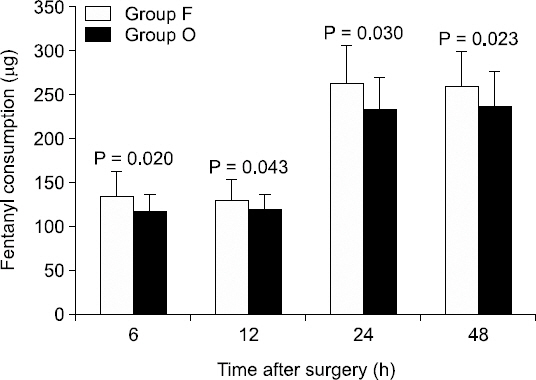Anesth Pain Med.
2016 Oct;11(4):349-353. 10.17085/apm.2016.11.4.349.
Oxycodone vs. fentanyl in the treatment of early post-operative pain after total knee replacement: randomized controlled trial
- Affiliations
-
- 1Department of Anesthesiology and Pain Medicine, Kyung Hee University Hospital, Seoul, Korea. ujuabba@gmail.com
- 2Department of Anesthesiology and Pain Medicine, Graduate School, Kyung Hee University, Seoul, Korea.
- KMID: 2358329
- DOI: http://doi.org/10.17085/apm.2016.11.4.349
Abstract
- BACKGROUND
Total knee replacement is often accompanied by severe post-operative pain. Oxycodone has sufficient analgesic effects and somewhat greater, but tolerable side effects compared to fentanyl. However, most studies on the topic evaluate visceral pain relief. In this study, we determine the effectiveness of oxycodone for somatic pain and evaluate the incidence of side effects.
METHODS
Sixty-nine patients were involved in a randomized control trial. Analgesic agents were administered to two experimental groups at a post anesthetic care unit (PACU) 15 min after PACU admission: a 50 µg fentanyl group (n = 40) and a 4 mg oxycodone group (n = 29), both with severe pain (numeric rating scale, NRS > 5). Changes in NRS at the PACU were measured. Additional analgesic agents were administered at 0-6, 6-12, 12-24, and 24-48 h after surgery.
RESULTS
Total fentanyl consumption and the number of patients who required additional opioids were significantly lower in the oxycodone group than in the fentanyl group. Incidence of side effects was not significantly different between the two groups.
CONCLUSIONS
Oxycodone shows a better analgesic effect than fentanyl in somatic pain in the acute phase of post-operative pain. The side effects of oxycodone are not significantly different from those of fentanyl.
MeSH Terms
Figure
Reference
-
1. Seo DK, Lee CJ, Kim JS. A comparison of oxycodone and fentanyl in the management of early postoperative pain and for patient-controlled analgesia after total abdominal hysterectomy. Anesth Pain Med. 2016; 11:176–81. DOI: 10.17085/apm.2016.11.2.176.
Article2. Hwang BY, Kwon JY, Kim E, Lee DW, Kim TK, Kim HK. Oxycodone vs. fentanyl patient-controlled analgesia after laparoscopic cholecystectomy. Int J Med Sci. 2014; 11:658–62. DOI: 10.7150/ijms.8331. PMID: 24843313. PMCID: PMC4025163.
Article3. Kalso E, Pöyhiä R, Onnela P, Linko K, Tigerstedt I, Tammisto T. Intravenous morphine and oxycodone for pain after abdominal surgery. Acta Anaesthesiol Scand. 1991; 35:642–6. DOI: 10.1111/j.1399-6576.1991.tb03364.x. PMID: 1785245.
Article4. Nuutinen LS, Wuolijoki E, Pentikäinen IT. Diclofenac and oxycodone in treatment of postoperative pain: a double-blind trial. Acta Anaesthesiol Scand. 1986; 30:620–4. DOI: 10.1111/j.1399-6576.1986.tb02487.x. PMID: 3544648.5. Tigerstedt I, Leander P, Tammisto T. Postoperative analgesics for superficial surgery. Comparison of four analgesics. Acta Anaesthesiol Scand. 1981; 25:543–7. DOI: 10.1111/j.1399-6576.1981.tb01702.x. PMID: 6810642.6. Tammisto T, Tigerstedt I, Korttila K. Comparison of lysine acetylsalicylate and oxycodone in postoperative pain following upper abdominal surgery. Ann Chir Gynaecol. 1980; 69:287–92. PMID: 6782930.7. Pöyhiä R, Olkkola KT, Seppälä T, Kalso E. The pharmacokinetics of oxycodone after intravenous injection in adults. Br J Clin Pharmacol. 1991; 32:516–8. DOI: 10.1111/j.1365-2125.1991.tb03942.x. PMID: 1958450. PMCID: PMC1368617.8. Takala A, Kaasalainen V, Seppälä T, Kalso E, Olkkola KT. Pharmacokinetic comparison of intravenous and intranasal administration of oxycodone. Acta Anaesthesiol Scand. 1997; 41:309–12. DOI: 10.1111/j.1399-6576.1997.tb04684.x. PMID: 9062618.
Article9. Pöyhiä R, Seppälä T, Olkkola KT, Kalso E. The pharmacokinetics and metabolism of oxycodone after intramuscular and oral administration to healthy subjects. Br J Clin Pharmacol. 1992; 33:617–21. DOI: 10.1111/j.1365-2125.1992.tb04090.x. PMID: 1389934. PMCID: PMC1381353.10. Leow KP, Cramond T, Smith MT. Pharmacokinetics and pharmacodynamics of oxycodone when given intravenously and rectally to adult patients with cancer pain. Anesth Analg. 1995; 80:296–302. DOI: 10.1097/00000539-199502000-00016. PMID: 7818116.
Article11. Maddocks I, Somogyi A, Abbott F, Hayball P, Parker D. Attenuation of morphine-induced delirium in palliative care by substitution with infusion of oxycodone. J Pain Symptom Manage. 1996; 12:182–9. DOI: 10.1016/0885-3924(96)00050-4.
Article12. Backlund M, Lindgren L, Kajimoto Y, Rosenberg PH. Comparison of epidural morphine and oxycodone for pain after abdominal surgery. J Clin Anesth. 1997; 9:30–5. DOI: 10.1016/S0952-8180(96)00212-7.
Article13. Koch S, Ahlburg P, Spangsberg N, Brock B, Tønnesen E, Nikolajsen L. Oxycodone vs. fentanyl in the treatment of early post-operative pain after laparoscopic cholecystectomy: a randomised double-blind study. Acta Anaesthesiol Scand. 2008; 52:845–50. DOI: 10.1111/j.1399-6576.2008.01643.x. PMID: 18477082.14. Park JH, Lee C, Shin Y, An JH, Ban JS, Lee JH. Comparison of oxycodone and fentanyl for postoperative patient-controlled analgesia after laparoscopic gynecological surgery. Korean J Anesthesiol. 2015; 68:153–8. DOI: 10.4097/kjae.2015.68.2.153. PMID: 25844134. PMCID: PMC4384403.
Article15. Silvasti M, Rosenberg P, Seppälä T, Svartling N, Pitkänen M. Comparison of analgesic efficacy of oxycodone and morphine in postoperative intravenous patient-controlled analgesia. Acta Anaesthesiol Scand. 1998; 42:576–80. DOI: 10.1111/j.1399-6576.1998.tb05169.x. PMID: 9605375.
Article16. Ordóñez Gallego A, González Barón M, Espinosa Arranz E. Oxycodone: a pharmacological and clinical review. Clin Transl Oncol. 2007; 9:298–307. DOI: 10.1007/s12094-007-0057-9.
Article17. Bisgaard T, Klarskov B, Rosenberg J, Kehlet H. Characteristics and prediction of early pain after laparoscopic cholecystectomy. Pain. 2001; 90:261–9. DOI: 10.1016/S0304-3959(00)00406-1.
Article18. Herrick IA, Ganapathy S, Komar W, Kirkby J, Moote CA, Dobkowski W, et al. Postoperative cognitive impairment in the elderly. Choice of patient-controlled analgesia opioid. Anaesthesia. 1996; 51:356–60. DOI: 10.1111/j.1365-2044.1996.tb07748.x. PMID: 8686825.
Article19. Watcha MF, White PF. Postoperative nausea and vomiting. Its etiology, treatment, and prevention. Anesthesiology. 1992; 77:162–84. DOI: 10.1097/00000542-199207000-00023.
Article
- Full Text Links
- Actions
-
Cited
- CITED
-
- Close
- Share
- Similar articles
-
- Comparison of oxycodone and fentanyl for postoperative patient-controlled analgesia after orthopedic surgery
- Oxycodone versus Fentanyl for Intravenous Patient-Controlled Analgesia after Laparoscopic Gynecologic Surgery
- A comparison of oxycodone and fentanyl in the management of early postoperative pain and for patient-controlled analgesia after total abdominal hysterectomy
- A comparison of oxycodone and fentanyl in intravenous patient-controlled analgesia after laparoscopic hysterectomy
- Comparison of oxycodone and fentanyl for postoperative patient-controlled analgesia after laparoscopic gynecological surgery



